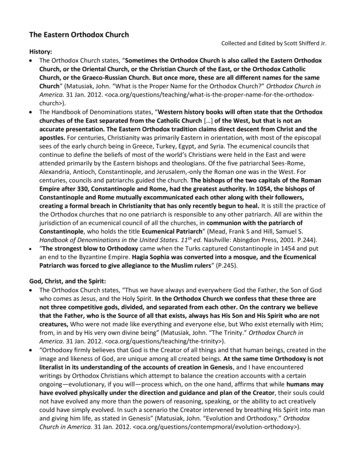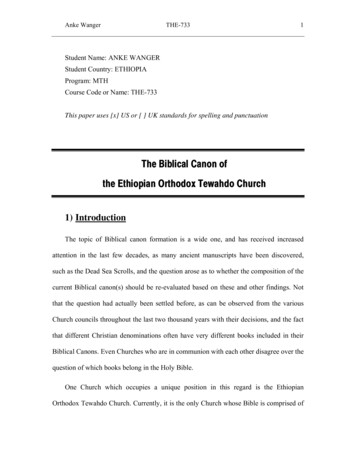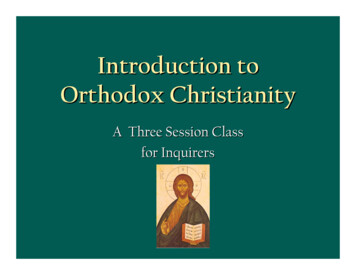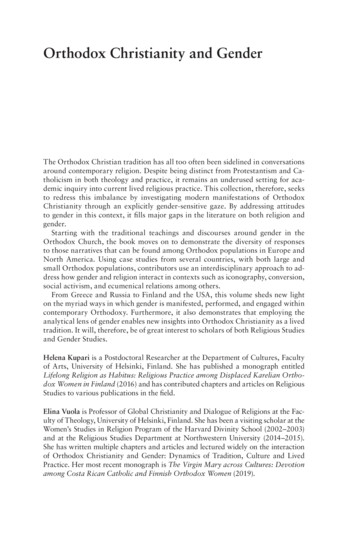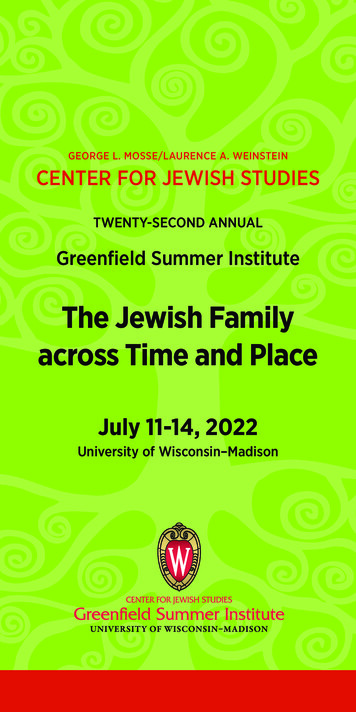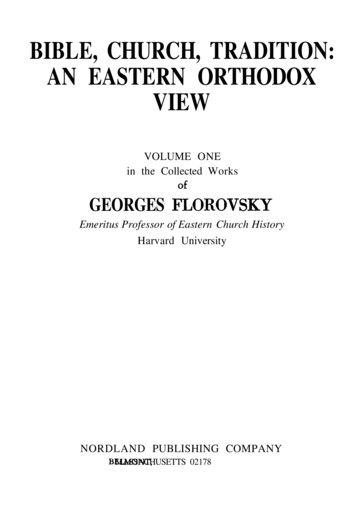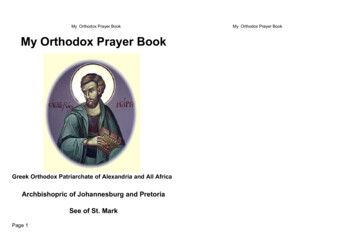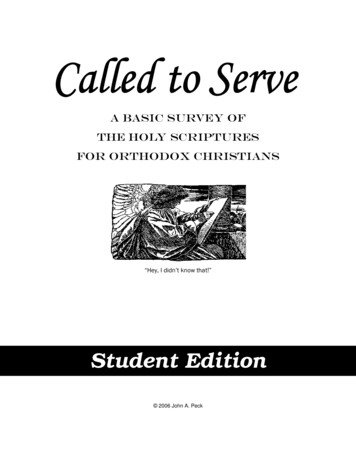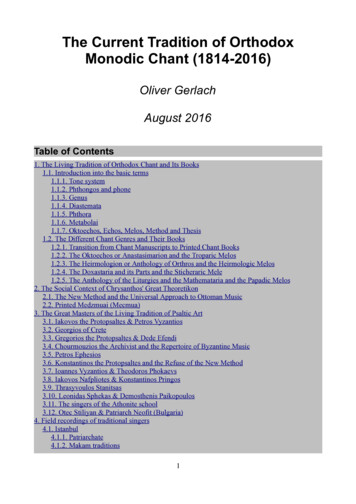
Transcription
The Current Tradition of OrthodoxMonodic Chant (1814-2016)Oliver GerlachAugust 2016Table of Contents1. The Living Tradition of Orthodox Chant and Its Books1.1. Introduction into the basic terms1.1.1. Tone system1.1.2. Phthongos and phone1.1.3. Genus1.1.4. Diastemata1.1.5. Phthora1.1.6. Metabolai1.1.7. Oktoechos, Echos, Melos, Method and Thesis1.2. The Different Chant Genres and Their Books1.2.1. Transition from Chant Manuscripts to Printed Chant Books1.2.2. The Oktoechos or Anastasimarion and the Troparic Melos1.2.3. The Heirmologion or Anthology of Orthros and the Heirmologic Melos1.2.4. The Doxastaria and its Parts and the Sticheraric Mele1.2.5. The Anthology of the Liturgies and the Mathemataria and the Papadic Melos2. The Social Context of Chrysanthos' Great Theoretikon2.1. The New Method and the Universal Approach to Ottoman Music2.2. Printed Medzmuai (Mecmua)3. The Great Masters of the Living Tradition of Psaltic Art3.1. Iakovos the Protopsaltes & Petros Vyzantios3.2. Georgios of Crete3.3. Gregorios the Protopsaltes & Dede Efendi3.4. Chourmouzios the Archivist and the Repertoire of Byzantine Music3.5. Petros Ephesios3.6. Konstantinos the Protopsaltes and the Refuse of the New Method3.7. Ioannes Vyzantios & Theodoros Phokaevs3.8. Iakovos Nafpliotes & Konstantinos Pringos3.9. Thrasyvoulos Stanitsas3.10. Leonidas Sphekas & Demosthenis Paikopoulos3.11. The singers of the Athonite school3.12. Otec Stiliyan & Patriarch Neofit (Bulgaria)4. Field recordings of traditional singers4.1. Istanbul4.1.1. Patriarchate4.1.2. Makam traditions1
4.2. Athos4.3. Bulgaria5. Bibliography and Links5.1. Common printed chant books5.1.1. Greek-Orthodox Books5.1.2. Old Church Slavonic Books5.1.3. Romanian Books5.2. Manuscripts5.3. Introductions5.3.1. Books5.3.2. Internet articles5.3.3. Exercises for modern (Chrysanthine) neumes5.3.4. Chant lessons (videos)5.3.5. Chant manuals for Church and Makam Music5.4. More particular studies1. The Living Tradition of Orthodox Chant and Its Books1.1. Introduction into the basic terms1.1.1. Tone systemsystema (τὸ σύστηµα, τὰ συστήµατα)1. Great perfect system (GPS) or heptaphoniaτὸ σύστηµα κατὰ ἑπταφωνίανthe system of solfège according to Chrysanthos' New Method1. Tetraphonia also known as Trochos systemτὸ σύστηµα κατὰ τετραφωνίανthe Papadic system of solfège (fifth aequivalence)τροχὸς "the wheel" (usually ascribed to Ioannis Koukouzelis)1. Lesser perfect system (LPS) or triphoniaτὸ σύστηµα κατὰ τριφωνίανthe system of the phthora nana (fourth aequivalence)1.1.2. Phthongos and phonethe phthongos (ὁ φθόγγος) "the voice"memorial place of a tone in the local imagination of a tone system (like a fret on the keyboard of an'ud or a tanbur) where each element has its place.A phthongos can be regarded as well as dynamic (with respect to the intervals, called diastemata between these elements) as thetic, independent from the possibility, that a genus change or transposition might alterthese intervals.2
the term should not be confused with the step between two phthongoi which is phone (ἡ φονή, pl. αἱφοναὶ "voice"):1 phone (e.g. ascending α —β , β —γ , etc. or downwards α —πλδ )2 phonai (e.g. ascending α —γ , β —δ , etc. or downwards α —υαρ)3 phonai (e.g. ascending α —δ , β —α , etc. or downwards α —πλβ )Latin treatises concerned about tone steps (Klangschrittlehre), here a third is called a step of twophonai (modern Greek phones), translated as "vox, voces".1.1.3. Genusgenos (τὸ γένος, τὰ γένη, genus, genera)1. the diatonic genussoft diatonic genusα β γ δ 12:11 88:81 9:89 7 12πα βου γα διDemosthenis Paikopoulos: Bereketes' Θεοτοκε παρθενεhttps://www.youtube.com/watch?v K93tEeejzcgbeginning in echos protos1. the chromatic genushard chromatic genus (echos plagios devteros)α β γ δ 7 18 3πλα πλβ υαρ7 16 5πα βου γα διDemosthenis Paikopoulos: Bereketes' Θεοτοκε παρθενεhttps://www.youtube.com/watch?v K93tEeejzcg&feature youtu.be&t 24m2ssection of echos plagios devterossoft chromatic genus (echos devteros)πλβ υαρ δ α β γ 7 12 7 14 7βου γα δι κε ζω νη Thrasyvoulos Stanitsas: Cherouvikon echos devteroshttps://www.youtube.com/watch?v fYfnQJ067xU1. the enharmonic genus3
genus of the phthora nana (echos tritos, echos varys, papadic echos plagios tetartos)πλδ α β γ 12 13 3νη πα βου γαDemosthenis Paikopoulos: Bereketes' Θεοτοκε παρθενεhttps://www.youtube.com/watch?v K93tEeejzcg&feature youtu.be&t 9m15ssection of echos tritoslike Pythagorean tuning, so that nana was also during the 20th century defined as hard diatonic, butthe Papadike regarded nana always as enharmonic1.1.4. DiastemataSince we spoke about the steps (phonai), we can now talk about intervals which are calleddiastemataHence, we can define all possible monophonai (one-step-intervals) of the soft diatonic genus: the great or major tone (ὁ µείζων τόνος)the largest interval of those three which divide the tetrachord (Chrysanthos 9:8) the middle tone (ὁ ἐλάσσων τόνος)the mediating interval between the largest and the smallest which divide the tetrachord(Chrysanthos 12:11) the small or minor tone (ὁ ἐλάχιστος τόνος)the smallest interval of three which divide the tetrachord (Chrysanthos 88:81)the tone (τόνος, tonus) was also used as Latin term for church mode as tonus ecclesiasticus,parallel to related terms like modus and tropus.Since the triphonos (three-step-interval) was usually a pure fourth (4:3), it consisted of fourphthongoi or chords and was called tetrachordon (τὸ τετράχορδον, tetrachordum), whereas thetetraphonos (four-step-interval) was usually a pure fifth (3:2), consisted of five phthongoi or cordsand was called pentachord (τὸ πεντάχορδον).The tetrachord in itself represented the system of intervals (as we have seen by the discussion ofmonophonai), while the pentachord was the one which usually represented the repetition of thesame order, since the (tetraphonic) system was based on fifth aequivalence.1.1.5. Phthoraphthora (ἡ φθορά) "destroyer"a) a sign for a mesos echos ("medial echos"), but also with an own melos that it is like an additionalechos (within the system of eight diatonic echoi)b) a sign for a genus change, as it was used to change into the chromatic genos of nenano, whilephthora nana was usually not indicated by a phthora, but by the great sign "xeron klasma"c) since the Papadike (14th century) a sign for a transposition, which usually referred to the diatonictetraphonia symbols or to the chromatic phthora4
d) since Chrysanthos it also was used as an alteration sign as well in ascending (δίεση) as indescending direction (ὕφεση)Chrysanthos used them to tune the "Byzantine" soft diatonic scale according to the intervals of acertain makam, Georgios Konstantinou used it to codify the microtonal attraction within the melee) since the 19th century additional shapes of phthorai could also indicate an exotic intervalstructure different from nana and nenano, and it was usually called after a certain makam.Especially frequented are three among them: nisabur / kliton:an attraction to the diatonic kyrios tetartosπλδ πλα β γ δ 12 20 4 4νη πα βου γα διthis intonation is used also for lessons recited according to the patriarchal stylePanayotis Koutras (Greek Byzantine anum/klang/epistel.mp3 müsteara simultaneous attraction of kyrios and mesos within the diatonic tetartos melosπλδ α β γ δ 18 3 16 3νη πα βου γα διKonstantinos Pringos: Heirmos kalophonikos Πᾶσαν τὴν ἐλπίδα µου in echos varyshttps://www.youtube.com/watch?v zp0FJMUIzOU&feature youtu.be&t 7m23s hisar:an attraction of the plagios, mesos, or kyrios within the diatonic protos melosπλα β γ δ α β γ 9 7 21 3 3 13πα βου γα δι κε ζω νη Konstantinos Pringos: Heirmos kalophonikos Πᾶσαν τὴν ἐλπίδα µου in echos varyshttps://www.youtube.com/watch?v zp0FJMUIzOU&feature youtu.be&t 2m58shttps://www.youtube.com/watch?v zp0FJMUIzOU&feature youtu.be&t 4m39sPanagiotis Keltzanidis integrated all the makamlar within the Byzantine oktoechos as certainaspects the echoi1.1.6. Metabolaimetabole (ἡ µεταβολή, pl. αἱ µεταβολαὶ) "the change, variation". We have to distinct four differentchanges, often two or three of them occur at the same time.1. ἡ µεταβολὴ κατὰ ἤχον5
the change of the echos within the melos (used within the papadic or sticheraric method to do thethesis of the melos)1. ἡ µεταβολὴ κατὰ γένοςthe genus change usually caused by phthora nana, phthora nenano, or one of the exotic phthorai1. ἡ µεταβολὴ κατὰ σύστηµαthe change of the tone system, the most common one is the change of phthora nana, because itchanges as well from the diatonic into the enharmonic genus, but also into the triphonic tone system1. ἡ µεταβολὴ κατὰ τόνονthe transposition which shifts the whole system of echos references (δύναµις) with respect to thephthongoi1.1.7. Oktoechos, Echos, Melos, Method and Thesisthe oktoechos (ὁ ὀκτώηχος), the book oktoechos (ἡ βίβλιος ὀκτώηχος)the system of eight diatonic sounds (and two phthorai), the eightfold sound or voice, the cycle ofeight weeks, each one in a acertain mode called echos (ὁ ἦχος, "sound, voice", Old Church Slavonicгласъ "voice")there is another term with a very similar meaning which is melos (τὸ µέλος, τὰ µέλη)it is partly used as a subcategory of echos, specified by a certain chant genre like the "papadic echosplagios tetartos", but the term originally was connected with the process of melos creation(melopoeia) like the method to do the thesis of the sticheraric melos, since the modal formulas andpatterns were known by heart, that there was no reason to write them down.On the other hand the papadic and sticheraric method included changes between the echoi, so that amelos could also change from one to another echos.The question is, what do experienced singers associate with the melos of a certain echos?1. Melopœiathe melopœia (ἡ µελοποιΐα) are the generative rules which make up a certain melos.The rules to create and to memorise modal patterns belonging to a certain melos havevarious parameters, which are:a) ambitusb) the particular function that certain tones (phthongoi) have within a melosc) an intonation formula called "echema", "enechema" or "apechema"d) cadence formulas (katálexeis) and their particular formal functione) a microtonal attraction called "melodic drives" (αἱ µελωδικές ἔλξεις)f) accentuation patterns which usually refer to simple psalmody functions of the phthongoithe principal notes with a certain emphasise can be characterised by three functionsK: cadential notes are those phthongoi used for open and final cadences, and the usuallycause a microtonal attractionF: the "finalis" is that phthongos which is aimed by the concluding cadence, usually it is6
identical with the phthongos of the final cadences, but in certain cases they are differentB: the base note is or base notes are simply called basis (ἡ βάση), in certain mele it is notjust one phthongos. The echos tritos has three base notes, which are all sung be the isonsingers (ἰσόκρατες). If there is only one base note it is often the same phthongos, where theconcluding and final cadences are made, but certain mele do not confirm this as a rule. cadencessing liturgical texts (canticles, psalms, scriptural readings, homiletic poetry like kontakion,stichera or odes of the canon) was always called "to say" themif you try to speak, you will see that nobody can understand a word, but if you sing it theywill understandthe concept recitation: a special vocal technique working with simple accentuation patternsand melodic endings which correspond to the melodic structure of the textThe so-called cadences derive from the term katálexe, and its organisation imitates thesyntactical structure of the text.ἡ κατάληξη "the ending, termination" open endings:αἱ ἀτελεῖς καταλήξειςall cadences which are not final, but on cadential notes closed endings:αἱ ἐντελεῖς καταλήξειςFinal cadences, which should not be mistaken as the concluding cadencesexplain the ambiguity of final cadences within the changing context between two echos(rather a concept of transition) concluding endings:αἱ τελικαὶ καταλήξειςConcluding cadences are different from final cadences, because they clearly indicate the endof whatever chant, so that the diacon or hieromonachos behind the iconostasis knows that hehas to continue his dialogues with the choir.2. Simple and complex psalmodypsalmody and accentuation patterns (I already did a whole workshop at Bratislava whichwas just about the medieval form of simple psalmody), not as montonous as Carolingianpsalmody)simple psalmody appeared first in Papadikai (as introduction to the sticherarion)in the old books of the cathedral rite the melismatic style of the cherouvikon and koinonikonare very close to accentuation pattern of simple psalmodymodern psalmody is defined according to New Method by the chant genres and their tempo,there is troparic psalmody in a fast tempo, sticheraric psalmody in a medial tempo,7
slow sticheraric psalmody in a slow tempo (sometimes even with genus changes)the past:traditional (palaion), or local differences between the Constantinopolitan (politikon,hagiosophitikon), the Thessalonian (thessalonikaion), the Hierosolymitan (hagiopolitikon)or the Athonite (hagioreitikon) way to recite psalmsbetween past and present:more complex forms of psalmody developed for the Ainoi-psalms (Laudate), the so-calledPolyeleoi:sound: Chourmouzios' Triadika polyeleon in echos legetos (Leonidas Sphekas, Chios)3. Kalophonia"beautified sound" (καλοφωνία) usually refers to the school of Ioannis Glykys and IoannisKoukouzelistoday it is known as the papadic chant genre (slow tempo, highly melismatic style withoccasional repetitions of syllables, with fast, sometimes even intersections using abstractsyllables like teretismata, or nenanismata)all kinds of metabolai (echos, genus, tone system, transposition) can be occurconcerning koinonika, they are sometimes also replaced by heirmoi kalophonikoi1.2. The Different Chant Genres and Their Booksall created during the 18th century as Constantinopolitan hyphos which means "the style of thePolis" (τὸ ὕφος πολιτηκὸν)every genre has a fixed repertoire of formulas, the accentuation patterns and a certain tempoaccentuation is defined by the treatment of the text syllabic genres like troparic and heirmologic chant are sung in a rather fast tempo stichera are regarded as a rather pneumatic genre which is supposed to be sung in a slowertempo melismatic genre is called papadic, the term derives from a theoretic manual called papadike(παπαδική) which has originally used between the 13th and 19th century, but it basicallyrefers to techniques of kalophonia (slow tempo, changes between echoi, genus, and tonesystem, prolongation by repetition of sections or kratemata, sections sung over abstractsyllables)one mathema in particular made up the most common method of papadic melopoeia: IoannisKoukouzelis' Mega Ison defined more or less the current understanding of psaltic art (ἡ ψαλτικὴτέχνη) and its kalophonia1.2.1. Transition from Chant Manuscripts to Printed Chant Books the hyphos and the integration of exoteric thesis of the melos (which had no traditionalmethod) the New Method as a neutralised use of neumes (details of performance became part of anoral tradition) in order to turn the Byzantine round notation into a universal notation suitableto transcribe all music traditions of the Ottoman empire and Europe (from Italian opera to8
Ottoman makam music) oktoechos chant refers to composers of the hyphos like Petros Peloponnesios, PetrosByzantios, Daniel the Protopsaltis, and Iakovos the Protopsaltes, although it delivers theircompositions in transcriptions made by Gregorios the Protopsaltis, Georgios of Crete, andChourmouzios the Archivist, students of Petros Byzantios and Iakovos we should not only mention books of church music, but also anthologies of makam music(and patriotic anthologies in order to teach music in Greek schools)1.2.2. The Oktoechos or Anastasimarion and the Troparic Melosthe earliest editions were Petros Ephesios' Anastasimatarion neon ascribed to Petros Peloponnesios (Bucharest1820):slide: extract of printed Anastasimatarion which has still the qualitative sign of oxeia Macarie Ieromonahul's Anastasimatariu Bisericesc (Romanian version transcribed in OldChurch Slavonic letters) (Vienna 1823):slide: extract of printed Anastasimatariu by Macarie Ieromonahultoday it is used in another version transcribed into Latin letters by Dimitrie Suceanu Nikolay Triandafilov's Voskresnik nov (Old Church Slavonic version for the Patriarchate ofBulgaria) (Bucharest 1847):slide: Triandafilov's Voskresniktoday Manasij Pop Todorov's edition (Sofia 1914) is more commonThe cycle of apolytikia anastasima and theotokia which has to be sung each dayEach section is dedicated to one of eight echoi and starts with the hesperinos psalm (Ps. 140)Daniel's Anastasimatarion syntomon, Petros' Anastasimatarion neon, and the short sticheraricversions of the Hesperinos psalm:folio: Birmingham, Cadbury Research Library, Mingana Collection, Ms. gr. 8, fol. 55r1.2.3. The Heirmologion or Anthology of Orthros and the HeirmologicMelosThe canon of the odes and eight mele within the modern heirmologic oktoechos (Petros thePeloponnesios' Katavasies, Petros Vyzantios' Heirmologion syntomon) Chourmouzios' transcription of the Heirmologion argon (Katavaseion) by PetrosPeloponnesios, and the Heirmologion syntomon by Petros Vyzantios (Istanbul 1825):slide: extract taken from Petros Peloponnesios' Katavaseion:sound: Thrasyvoulos Stanitsas with the diatonic tritos intonation (officially echos legetos, mesostetartos):slide: extract taken from Petros Byzantios' Heirmologion syntomonstill in use today (in reprint)In Bulgaria today, there is no print version of pure heirmologion, it is rather a combination of the9
Anthology of Orthros and the heirmologion (in fact, only Petros Peloponnesios' katavaseion): Manasiy Pop Todorov's Psaltikiyna Utrenna (Sofia 1914)still in use today (in reprint)1.2.4. The Doxastaria and its Parts and the Sticheraric MeleThe old sticherarion, the mathemata, and the abridged version of the doxastarion (Petros'Doxastarion syntomon, Iakovos' Doxastarion argon, Konstantinos' Doxastarion argosyntomon)the transformation of the old sticherarion between Georgios Raidestinos, Panagiotes the NewChrysaphes, Germanos of Neo PatrasChourmouzios' transcription into the New Method (Doxastarion of Germanos of Neo Patras: EBE747-750; Doxastarion of New Chrysaphes: EBE 761-165; own transcription of the old sticherarion:EBE 707-709, 715)Petros Peloponnesios' Doxastarion syntomon (many copies in manuscript) Petros Ephesios' Doxastarion (Bucharest 1820):slide: extract with the Doxastikon oktaechon (end plagios protos, beginning echos devteros section)Iakovos the Protopsaltes' Doxastarion argon was transcribed by his student Georgios of Crete (manycopies in manuscript) Chourmouzios' transcription of the Doxastarion argon into the New Method (Constantinople1836):slide: same extract in the melos sticherarikon argonConstantinos the Protopsaltes' Doxastarion argosyntomon was written in the old notation, sinceConstantinos refused the New Method Stephanos the Domestikos' transcription of Constantinos the Protopsaltes' Doxastarionargosyntomon (Constantinople 1841):slide: same extract in the melos sticherarikon argosyntomonIakovos Nafpliotis hyphos version of the Doxastarion was taught as an oral tradition, buttranscribed by one of his students, Angelos Boudouris1.2.5. The Anthology of the Liturgies and the Mathemataria and thePapadic MelosThe papadic melos and the psaltic art (cherouvika, koinonika, sticheronkalophonikon/anagrammatismos, heirmos kalophonikos, Polyeleos)the usual composition of an Anthology of the Liturgies is despotika (processional acclamationsduring the entrance of an abbot or bishop, sometimes the oktoechos cycle for the ektenia, the typika(entrance psalms and makarismoi), the trisagia and anti-trisagia, the cherouvikon cycles, the cyclefor the dialogues for the liturgy, the Axion estin or their heirmologic substitutes, the koinonikoncycles, a separate heirmologion kalophonikon on the last pages (rarely in the usual oktoechos order)Heirmologion kalophonikon in exegetic notation, mainly Petros Bereketes, Balasios the Priest,Ioannis Trapezountios etc. (many copies in manuscript, Birmingham, Cadbury Research Library,like Ms. Mingana gr. 6) Gregorios the Protopsaltes' transcription of the heirmologion kalophonikon with10
kratimatarion (published by Theodoros Phokaeos, Istanbul 1835)Chourmouzios' transcription of the mathematarion / sticherarion kalophonikon (8 volumes, EBE727-734) Print edition of the mathematarion2. The Social Context of Chrysanthos' Great TheoretikonThe creation of a universal notation system for Mediterranean Music2.1. The New Method and the Universal Approach to Ottoman MusicThe tanbur as common reference of the tone system, the discrepance between the heptaphonia ofmonosyllabic solfège and the tetraphonia of the polysyllabic solfège:slide:Chrysanthos' method to adapt to various makam intervals:slide:Keltzanides' method:slide:2.2. Printed Medzmuai (Mecmua)The secret about Petros and the Mevlevi of PeraPrinted anthologies by Keivelis (Apanthisma & Medzmouai), Keltzandidis (Didactic method),Phokaeos & Chourmouzios (Evterpe).3. The Great Masters of the Living Tradition of Psaltic Art3.1. Iakovos the Protopsaltes & Petros VyzantiosIakovos was originally a rival of Petros Peloponnesios, since Petros jumped the cue and took theposition as Lampadarios which was supposed to become the one of Iakovos, since he was the firstdomestikos. When Petros promoted, he invited Petros Vyzantios, a gifted musician and ney playerwho had grown up in Yeniköy (Neochori), to follow him in the position of the second domestikos.After Petros Peloponnesios' death during a plague in 1778, Iakovos left the Patriarchate, andcontinued decades later his career there. It was Petros Vyzantios who followed his teacher andmentor as Lampadarios. Both were teachers at the New Music School, but Iakovos refused therhythmic style of Petros' Doxastarion which he taught his follower.3.2. Georgios of CreteGeorgios of Crete (ca. 1790-1815) was student of Iakovos the Protopsaltes and a very importantfigure of the current tradition, since he transcribed Iakovos' Doxastarion into exegetic neumenotation, and he taught the great teachers like Gregorios the Protopsaltes and Chourmouzios whowill transcribe the whole repertoire (inlcuding Iakovos' contributions) according to the NewMethod.11
3.3. Gregorios the Protopsaltes & Dede EfendiGregorios the Protopsaltes was a very modern and open-minded composer, his parents alwaysemphasised he was born on the same day, when Petros Peloponnesios died. The parents also saidthat their son was teaching himself Armenian and Armenian chant, when he was young. In order tobe educated in Greek grammar he was sent to the Lavra of Saint Catherine in Mount Sinai.His completed his education as chanter at the Patriarchate as a student of Georgios of Crete,Georgios' teacher Iakovos, but also of Petros Vyzantios. Already in a later age, he learnt Turkish,because it was the condition of the Mevlevi composer Dede Efendi, after he asked him to join himas student.3.4. Chourmouzios the Archivist and the Repertoire of Byzantine MusicChourmouzios was born in Halke (Heybeliada). He studied Orthodox chant and the Byzantineheritage with Georgios of Crete, Petros Vyzantios, and Iakovos. Since he made no career as anArchon Protopsaltes at the Patriarchate, he got the title "Archivist" (Chartophylakos), but as studentof such illustrious teachers and the best skilled concerning the huge Byzantine repertoire (includingthe sticherarion kalophonikon) he sang in other churches and also at St Catherine's in Sinai. LikeGregorios the Protopsaltes he was in charge to transcribe, and he had to continue alone after theearly death of Gregorios in 1821.Manuscript collection with Chourmouzios' transcriptions (within the collection of the Metochion ofthe Holy Sepulchre, MPT):1. Kratemataria, 2 vol. (EBE-MPT 710-711)2. Anthologia of the Papadike, 3 vol. (EBE-MPT 703-705)3. Mathematarion of the Papadike, 2 vol. (EBE-MPT 706, 722)4. Anastasimatarion of Panagiotes the New Chrysaphes (EBE-MPT 758)5. Sticherarion of Germanos the New Patras, 4 vol. (EBE-MPT 747-750)6. Sticherarion of Panagiotes the New Chrysaphes, 5 vol. (EBE-MPT 761-765)7. Complete works by Petros Bereketes (EBE-MPT 712)8. Anastasimatarion of the Old Sticherarion (EBE-MPT 702)9. Old Sticherarion, 4 vol. (EBE-MPT 707, 715)10. Mathemataria of the Sticherarion, 8 vol. (EBE-MPT 727-734)11. Oikematarion, 2 vol. (EBE-MPT 713-714)An early autograph dating 1792 was still written in Middle Byzantine notation.3.5. Petros EphesiosHe was born at Kusadasi, he lived in Constantinople and Bucarest, where he became active as theeditor of the first print publications of the New Method (Petros Peloponnesios' Doxastarion andAnastasimatarion) and a first Anthology for Orthros (Bucarest 1830). The early typography he usedstill included the neume sign of oxeia, after he decided in exchange with the Great teachers toreplace the ornamental sign oxeia by a simple oligon combined with psephiston (one step up withaccent).12
3.6. Konstantinos the Protopsaltes and the Refuse of the New MethodLike Chrysanthos, Chourmouzios and Gregorios Konstantinos was born in the seventies (1777) andactually belonged to the same generation, but unlike the three "Great Teachers" he refusedChrysanthos' New Method and stuck to the exegetic notation of the hyphos school. GeorgiosPapadopoulos wrote about his use of notation that "he surpassed in the analytical form ofcomposition, writing melodic lines by the simple use the characters of quantity, without thehieroglyphic great signs." After Iakovos' death in 23 April 1800, Konstantinos entered thePatriarchate as second domestikos, after Petros Byzantios left, he became first domestikos, and withthe death of his teacher Manuel the Protopsaltes (21.6.1819) he promoted to the position ofLampadarios, where he replied to the great teachers, but only two years later Gregorios left due toan illness, so that he already became Protopsaltes in 1821, and stayed there until 1855, when he left"for an air change" to Halke. But he kept his title until his death on 30 June 1862. He served for 55years at the klir.And his contribution is not only his own abridged sticherarion, mediating between Iakovos andPetros Peloponnesios and transcribed by Stephanos the Domestikos, but also his contribution toKeltzanides' book concerning the transcription of a mathema to learn all the makamlar by asequence of seyirler. There is a hand-drawing in Keltzanides' book which shows a Persian tanbur,the common reference of the tone system for Ottoman musicians (similar to the 'ud in medievaltimes), it represents the heptaphonic tone system of the New Method, but there are also calculationof makam intervals.3.7. Ioannes Vyzantios & Theodoros PhokaevsNext Konstantinos and his alumni Stephanos, there are two Archon Protopsaltes of a fine reputationwho were very active as publishers of chant books which are still in use today.Ioannis should not be confused with Ioannis Trapezountios who died in 1770. As usual we do nothis exact birth date, but he was doestikos (1824-1831), lampadarios (1831-1855) and firstprotopsaltes of the Great Church (1855- † 1866).Theodoros name Phokaevs refers to his birthplace Phokaia (Turkish Foça) near Smyrna (ca. 1790),he studied with Georgios of Crete, Gregorios the Protopsaltes und Chourmouzios at the ThirdMusic School of the Patriarchate (1815-1821). He sang with Chourmouzios in two churches AgiosDemetrios of Tatavla (Tr. Kurtuluş) and Agios Nikolaos in the Galata district of the Polis.Theodoros was involved in all important chant editions, including the famous and vast collectionsof makam music published under the name "Evterpe" and "Pandora."3.8. Iakovos Nafpliotes & Konstantinos PringosIakovos Nafpliotes, born in 1864 on the island of Naxos, was as a protopsaltis one of the firstmusicians who had been recorded and published by Odeon. After his family moved to the Polis in1870, he went to the school of Fener (Fener Rum Lisesi, the buidling today was constructedbetween 1881-1883). He served first as a kanonarchis at the Patriarchal cathedral, when he was onlyten years old. His career at the Patriarchate: first domestikos (1882-1888), second domestikos(1888-1905), lampadarios (1905-1911) and finally archon protopsaltes (1911-1939).Iakovos refused notation as a whole, although he founded a series of publications called"Phorminx" which was later continued by Konstantinos Psachos, he also contributed to a secondedition of Petros Peloponnesios' Doxastarion after Petros Ephesios' first edition published in 1820.Today, Iakovos and his followers (after such a long period of service he had plenty, includingKonstantinos Pringos) are called the "Old School of the Patriarchate", because they relied (like13
Konstantinos the Protopsaltes) entirely on an oral tradition of the hyphos. Nevertheless, one of hisnumerous students, Angelos Voudouris, transcribed it manually according to the New Method.Together with the early recordings, his art could be preserved into the very detail, while earlierProtopsaltes are usually just known by their printed publications and the entry about their servicesat the Patriarchate.Konstantinos Pringos (1892-1964) joined the Patriarchate as an already famous psaltis who didnumerous services in Greece, Chios, and Bosporus, in 1911: second domestikos (1911-1913),archon lampadarios (1938-1939) and archon protopsaltes (1939-1959). He continued Iakovos' seriesunder the name "The Patriarchal Phormix", and he planned many editions of the whole repertoire,including an own Doxastarion out of the oral hyphos tr
The Living Tradition of Orthodox Chant and Its Books 1.1. Introduction into the basic terms 1.1.1. Tone system 1.1.2. Phthongos and phone 1.1.3. Genus 1.1.4. Diastemata 1.1.5. Phthora 1.1.6. Metabolai . a sign for a mesos echos ("medial echos"), but also with an own melos that it is like an additional echos (within the system of eight .


